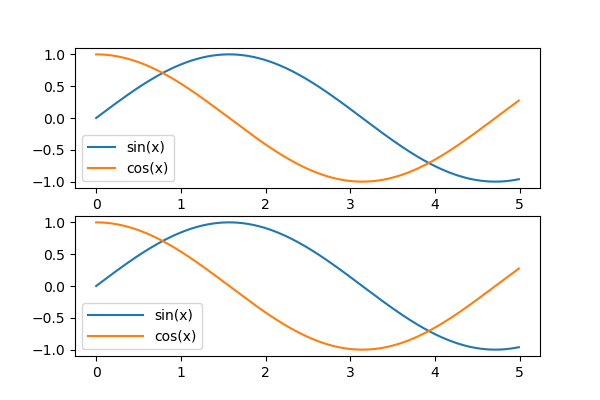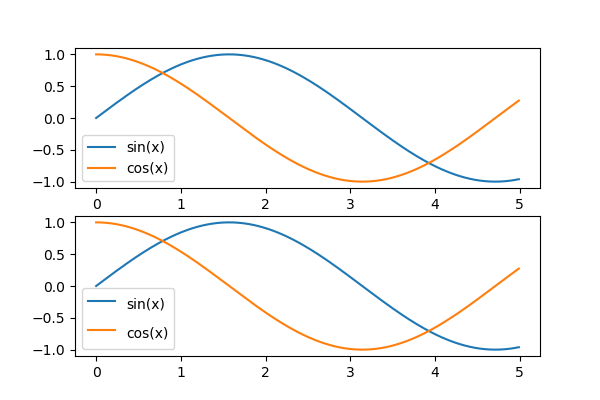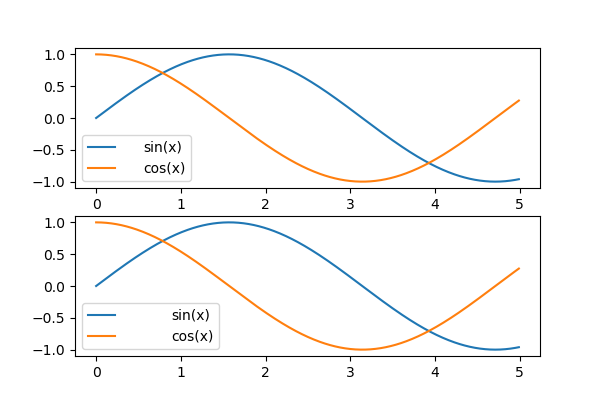Matplotlib legend参数详解
Matplotlib legend参数详解
legend在画图中用于设置生成图例,只需要在代码中添加plt.legend()则会自动根据前面画图中的label绘制图例,如下图所示:
import math
import matplotlib.pyplot as plt
import numpy as np
x = np.arange(0, 5, 0.01)
y = [math.sin(i) for i in x]
plt.plot(x, y, label="sign(x)")
plt.legend()
plt.show()

图例有许多参数可供调整,在官方文档中列举了plt.legend的一系列参数设置,这里简要摘出来一些常用的参数和配置进行介绍:
图例位置#
图例显示最主要的调整即为位置,如果选择显示图例在画图区域内部,则可以配置loc参数
| 字符表示 | 代号 |
|---|---|
| 'best' | 0 |
| 'upper right' | 1 |
| 'upper left' | 2 |
| 'lower left' | 3 |
| 'lower right' | 4 |
| 'right' | 5 |
| 'center left' | 6 |
| 'center right' | 7 |
| 'lower center' | 8 |
| 'upper center' | 9 |
| 'center' | 10 |
import math
import matplotlib.pyplot as plt
import numpy as np
x = np.arange(0, 5, 0.01)
y = [math.sin(i) for i in x]
labelList = ['best', 'upper right', 'upper left', 'lower left', 'lower right', 'right', 'center left', 'center right', 'lower center', 'upper center', 'center']
plt.figure(figsize=(12, 12))
for i in range(11):
plt.subplot(4, 3, i+1)
plt.plot(x, y, label=labelList[i])
plt.legend(loc=i)
plt.show()

位置标注如上,一般选择loc=0,会自动调整最佳的位置放置图例,如果挡住重要的数据点,则可以通过plt.xlim和plt.ylim调整坐标轴大小,调整数据点位置。
此外,对于需要将图例放置在图外的情况,可以设置bbox_to_anchor,通过手动调节的方式设置图例位置,如下图所示:
import math
import matplotlib.pyplot as plt
import numpy as np
x = np.arange(0, 5, 0.01)
y = [math.sin(i) for i in x]
plt.figure(figsize=(6, 4))
plt.plot(x, y, label="sign(x)")
plt.legend(loc=0, bbox_to_anchor=(0.25, 1.15))
plt.show()

图例大小#
labelspacing(default: 0.5):上下图例之间的距离
plt.subplot(2, 1, 1)
plt.plot(x, y1, label="sin(x)")
plt.plot(x, y2, label="cos(x)")
plt.legend(loc=0, labelspacing=0.5)
plt.subplot(2, 1, 2)
plt.plot(x, y1, label="sin(x)")
plt.plot(x, y2, label="cos(x)")
plt.legend(loc=0, labelspacing=2)

handlelength(default: 2.0):图例左侧图像的宽度
plt.subplot(2, 1, 1)
plt.plot(x, y1, label="sin(x)")
plt.plot(x, y2, label="cos(x)")
plt.legend(loc=0, handlelength=2)
plt.subplot(2, 1, 2)
plt.plot(x, y1, label="sin(x)")
plt.plot(x, y2, label="cos(x)")
plt.legend(loc=0, handlelength=4)

handleheight(default: 0.7):图例左侧图像的高度
plt.subplot(2, 1, 1)
plt.plot(x, y1, label="sin(x)")
plt.plot(x, y2, label="cos(x)")
plt.legend(loc=0, handleheight=0.7)
plt.subplot(2, 1, 2)
plt.plot(x, y1, label="sin(x)")
plt.plot(x, y2, label="cos(x)")
plt.legend(loc=0, handleheight=2)

handletextpad(default: 0.8):左侧图例和右侧文字之间的距离
plt.subplot(2, 1, 1)
plt.plot(x, y1, label="sin(x)")
plt.plot(x, y2, label="cos(x)")
plt.legend(loc=0, handletextpad=2)
plt.subplot(2, 1, 2)
plt.plot(x, y1, label="sin(x)")
plt.plot(x, y2, label="cos(x)")
plt.legend(loc=0, handletextpad=4)

borderaxespad(default: 0.5):图例和坐标轴之间的边距
plt.subplot(2, 1, 1)
plt.plot(x, y1, label="sin(x)")
plt.plot(x, y2, label="cos(x)")
plt.legend(loc=0, borderaxespad=0.5)
plt.subplot(2, 1, 2)
plt.plot(x, y1, label="sin(x)")
plt.plot(x, y2, label="cos(x)")
plt.legend(loc=0, borderaxespad=2)

columnspacing(default: 2.0):两个横向图例间的距离,这里设置ncol=2即标明图例按照两列进行排列

plt.subplot(2, 1, 1)
plt.plot(x, y1, label="sin(x)")
plt.plot(x, y2, label="cos(x)")
plt.legend(loc=0, ncol=2, columnspacing=2)
plt.subplot(2, 1, 2)
plt.plot(x, y1, label="sin(x)")
plt.plot(x, y2, label="cos(x)")
plt.legend(loc=0, ncol=2, columnspacing=4)




【推荐】国内首个AI IDE,深度理解中文开发场景,立即下载体验Trae
【推荐】编程新体验,更懂你的AI,立即体验豆包MarsCode编程助手
【推荐】抖音旗下AI助手豆包,你的智能百科全书,全免费不限次数
【推荐】轻量又高性能的 SSH 工具 IShell:AI 加持,快人一步